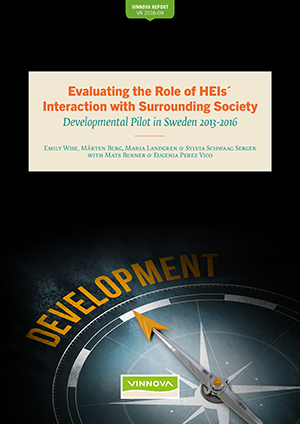Evaluating the Role of HEIs´ Interaction with Surrounding Society
Developmental Pilot in Sweden 2013-2016

Evaluating the Role of HEIs´ Interaction with Surrounding Society
Go directly to the reportReport on government commission
Driven by increased expectations on the use of knowledge to benefit sustainable social development and growth, the government’s research and innovation bill in 2012 highlighted the need to develop new incentives and structures to foster universities’ interaction with surrounding society. Following this, the government assigned Vinnova the task of developing methods and criteria for assessing the performance and quality of universities’ societal interaction.
In responding to the government assignment, Vinnova’s ultimate aim was to strengthen the quality and relevance of research and education through developing the societal interaction of HEIs and in turn bolstering Swedish HEIs’ attractiveness and competitiveness globally. Thus, our focus was not on creating metrics, but rather on designing an approach to incentivize HEI’s own continual development of their interaction with surrounding society.
But how to influence such a development process in a meaningful way, especially given Sweden’s diverse HEI landscape? Our answer was to devise a model for evaluation of societal interaction through a collaborative process together with Swedish HEIs and other stakeholders.
Starting in 2013, Vinnova has led an inclusive and interactive process to develop a model for evaluating HEIs’ interaction with society. The process has leveraged external knowledge, international expertise, and most importantly actively involved 27 Swedish HEIs. As we near the end of our government assignment and look back, we take the opportunity to reflect on the process and its results – what worked well or less well? What did we achieve? What did we learn? What is still left to do?
This document tells this story – or at least the first part of the story, as the process has only just begun. It is not an academic paper or technical report, but rather an account of the last four years – including the facts, some illustrative examples of HEI activities, and reflections on the process and its results.
- Published
- 2016-November
- Series number
- VR 2016:09
- Publisher
- Vinnova
- Author
- Emily Wise, Mårten Berg, Maria Landgren & Sylvia Schwaag Serger with Mats Benner & Eugenia Perez Vico
- ISBN
- 978-91-87537-55-4
- ISSN
- 1650-3104
- Number of pages
- 48
Last updated 15 December 2022

